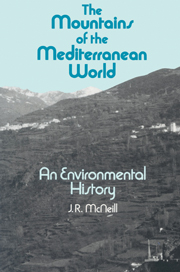Book contents
- Frontmatter
- Contents
- List of Illustrations and Tables
- Preface
- Note on Transliteration
- List of Abbreviations
- 1 The Argument: Ecology, Economy, Shells, and Skeletons
- 2 Mediterranean Mountain Environments
- 3 The Deep History of Mediterranean Landscapes
- 4 Material Life in the Mountain Environment, 1700–1900
- 5 Population, Settlement, and Landscapes
- 6 Political Economy and Mountain Landscapes
- 7 The Changing Landscape since 1800
- 8 Conclusion
- Bibliography
- Index
3 - The Deep History of Mediterranean Landscapes
Published online by Cambridge University Press: 29 September 2009
- Frontmatter
- Contents
- List of Illustrations and Tables
- Preface
- Note on Transliteration
- List of Abbreviations
- 1 The Argument: Ecology, Economy, Shells, and Skeletons
- 2 Mediterranean Mountain Environments
- 3 The Deep History of Mediterranean Landscapes
- 4 Material Life in the Mountain Environment, 1700–1900
- 5 Population, Settlement, and Landscapes
- 6 Political Economy and Mountain Landscapes
- 7 The Changing Landscape since 1800
- 8 Conclusion
- Bibliography
- Index
Summary
My Italy…. Words are in vain, for the mortal wounds, which I see so numerous in your beautiful body.
Petrarch, Italia MiaMillennia of human activity have weighed heavily upon Mediterranean lands, but far less so in the mountains than on the plains and low hills. The reasons for this are simple: the economic activities that have underlain Mediterranean civilizations rested on lowland crops and trade between coastal zones. The vine and the olive do best below 500 meters, and wheat, the third member of the Mediterranean agricultural trinity, is planted at higher altitudes only when all fertile lowland is used or used up. The timber trade, though an important business in ancient times, scarcely reached the high mountains. Until rather recently, only grazing animals and fires set by their keepers affected mountain vegetation and soils in an important way. Even grazing seems to have expanded greatly in Mediterranean areas in the past thousand years, so that its previous impact may well have been slighter than its recent effect. In general, where human populations have been great, so has landscape degradation. And where human populations have fluctuated greatly, degradation has been greater still. Only very rarely in ancient and medieval times could small numbers of people inspired by the demand of distant markets affect landscapes fundamentally. The modern period, as we shall see, was quite different in this respect.
- Type
- Chapter
- Information
- The Mountains of the Mediterranean World , pp. 68 - 103Publisher: Cambridge University PressPrint publication year: 1992



